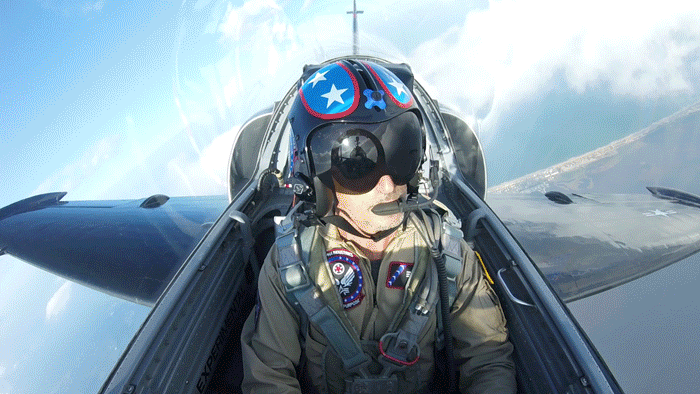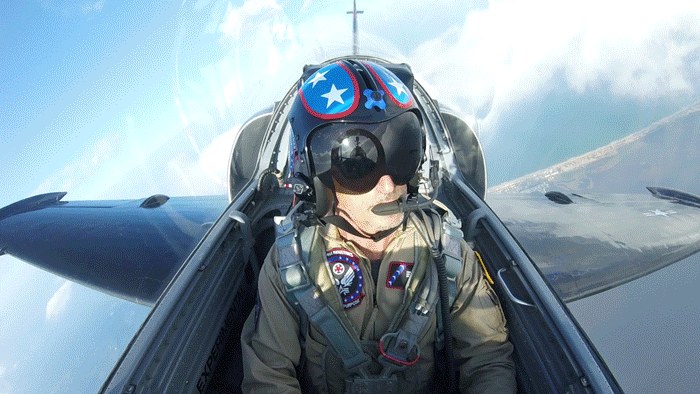
Mark “Crunchy” Burgess is not the thick, beefy, Iceman-type of fighter pilot who spends his time promoting his upper-body definition and flight hours. He’s methodical and quiet — often pinpoint — in his words, manners and speech. The kind of guy to sit, arms folded, listening to a debate or a monologue or a branch-superiority battle unfold until finding the perfect moment to jump in and dismantle everything and everyone around him with precision, and physics, and the assured, unforced calm that comes with craft mastery. Crunchy has nearly 4,000 flying hours to his name. Upon my arrival at the NAS Oceana Air Base for a test flight in mid-September, my count was precisely 4,000 less.
Crunchy — no one calls him anything else, and I didn’t even know how to pronounce his last name until 20 minutes before I left — is a retired Navy lieutenant commander and the lead pilot with the Warrior Flight Team, an all-volunteer charity organization that raises funds for wounded vets partly by taking hopelessly green writers up in flights that they inexplicably call “VIP rides.” (On a master jet base populated by active-duty servicemen and women, my VIP status is basically rock bottom.) My flight was a once-in-a-lifetime opportunity to spin space, to actually no-shit-for-real-aileron-roll-a-jet, to fly a fighter for about 30 exhilarating seconds. For these men and women, this was a pretty routine Friday.
Our plane was an L-39, a Czech-made training fighter jet that debuted in the ‘60s and remains in regular use today, particularly in eastern Europe. And it’s owned by Pat “Villain” Marsh, the kind of pilot whose mathematically square jaw, life-spent-outdoors-skin and crisp demeanor convey two rules: 1. You and I are not yet on joking terms and 2. Do not fuck up my plane.
I lived my two days at the NAS Oceana Air Base in Virginia Beach in fear of fucking up his plane. The Warrior Flight Team, in conjunction with the military-inspired fashion company Alpha Industries, uses it for their air show, a military sky-dance of murderous physics, spins and twirls, drops and corkscrews, speed and unpowered gravity, and gut-flattening angles both up and down. Crunchy, with a little advance warning, could make the jet do a Cha-Cha Slide if he wanted it to.
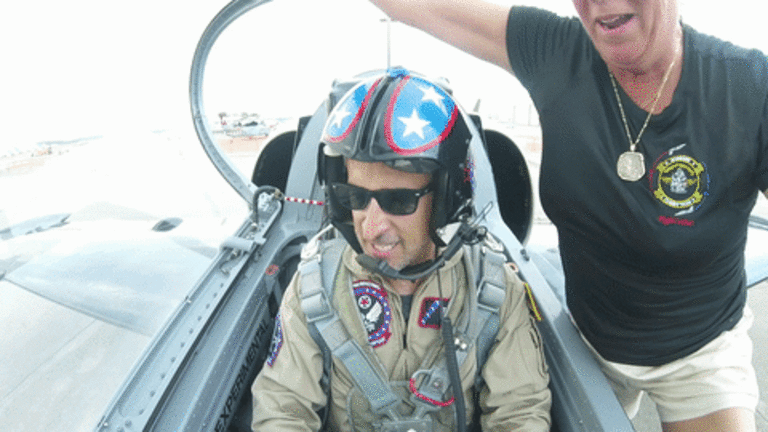 FacebookPinterest
FacebookPinterestAs it happened, my flight was the last of the day, which left me plenty of time to anticipate one of the greatest thrills of my life by obsessing about one crucial question: Am I going to throw up? For the record, there are myriad ways to not throw up. Before our flight, pilot and team narrator/writer Doug Woodley, a pilot in Operations Enduring Freedom and Iraqi Freedom and whose call sign is either “Dagwood” or “Pecker” depending on what my editors decide is appropriate for Golf Digest, gave me a two-minute brief about how not to minimize the chances. Crunch your abs when you start pulling Gs to equalize the force against your body. Focus on the horizon to minimize the effects of the surreal scene passing in your peripheral vision. Take the flight controls, as nausea can often be dampened by feeling more in control of whatever situation is causing it. It was all good advice, and I should really have written it down somewhere so I could have remembered it when I was on the plane.
By showtime, I had been among pilots, active duty servicemen and women and decorated Navy and Air Force veterans for two days. I had suited up in my gear, call sign Scribe. I was as prepped as I was going to be. A brilliant late-afternoon sun readied to break over the edge of a massive storm cell, creating a near-tent of Jacob’s ladders in the airspace just south of the airfield. “That’s a good sign,” said the team’s accomplished artist, Gary Velasco, “unless it’s an invitation.”
And in a sudden expert flurry of clicks, bangs, plugs and a final safety briefing — which boiled down to Marsh instructing me not to touch anything painted red — suddenly there I was, in a fighter jet. It’s weird to be in a fighter jet. You are committed. You’re locked in. Even if you were beset by a sudden rush of instant panic — which I wasn’t, inexplicably — you’re stuck. I was in the back of the two-seater, in a bathtub of dials and switches that might have well been written in Martian. It’s hot. It’s very hot. Sweat-waterfalls-down-your-back-hot, can’t-see-through-the-sunglasses hot. But you’re in. And one way or another, you’re about to have a hell of a half-hour. “Most fun you can have,” Crunchy crackled over the comm, “with your clothes on.”
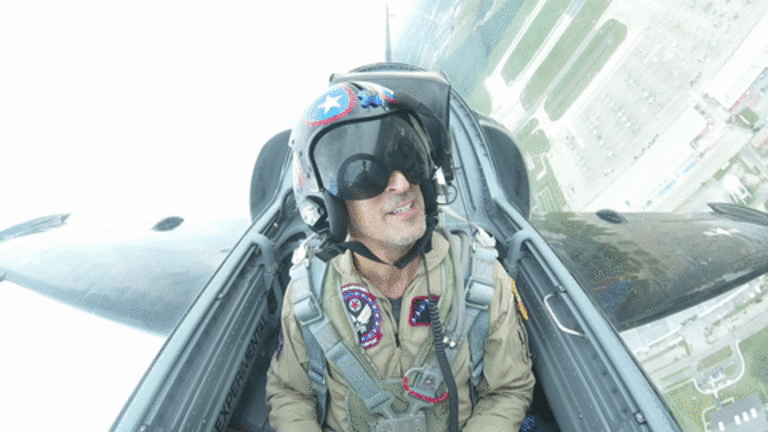 FacebookPinterest
FacebookPinterestThe takeoff, perfect. The bank around the airfield, perfect. The straightening out and heading south, I have no idea, because all I saw was the world in all directions, an unprecedented, unphotographable, idiotically majestic 180-degree view of land and ocean. I don’t know what I said to Crunchy, but it was essentially the words “holy” and “shit” in multiple combinations. He leveled off while I gazed, staring at the blues in the ocean, the inlets of coastal Virginia, the sun finishing breaking past the edge of the mountain of clouds. One's first instinct is to take a picture, which is as useless as it is at the Grand Canyon, or at Yosemite. Nothing compares. I stared.
But we hadn’t come up here for an airliner ride. “Let’s do some stuff,” Crunchy said, and the show was on. First up, pulling some Gs. Not many — about three, or three times the force of gravity, enough to shove my pelvis down back into the seat but not enough to cause too much discomfort. Crunchy was testing me early, and I think I’d passed the prelim.
That meant it was my turn to fly. My throttled mirrored Crunchy’s, so when he pulled left, I felt the controls respond. When he pushed right, I felt the appropriate direction and force. When he pulled back, which angled the plane up 10 degrees and increased the Gs, the enormity of the situation crushed into me, roughly a half-second before he told me, “You have the flight controls,” to which my response would have been “I have the flight controls” if I hadn’t forgotten it, along with my job, location, hair color and name. But for some blink of time, not even 30 seconds, I flew a fighter jet. I turned left, evened it out, then brought it back right. I was halting, gentle, figuring that the slightest motion would send the plane careening into the waters off Virginia Beach, which is the opposite of what you’re supposed to do: crush the throttle authoritatively. (Crunchy, with four million hours of flying experience as a pilot and instructor, assured me there was literally nothing I could do to damage the jet, and my mind reeled through the alarming number of times I’ve nearly dropped my phone in a toilet.)
And then we started the aileron rolls, which is when, using a complicated aviation technique called “pulling the throttle to the right,” you do a full 360-degree roll of the plane. I rolled the plane. I pulled right on the stick, and everything spun: the plane, horizon, sky, ocean, my upper GI tract. If I achieve nothing else in my life, someone put on my tombstone, “Here Lies Jeff, Once in 2017, Through the Effort and Expertise of Like 20 Much Sharper People, He Rolled a Fighter Jet.” It’s very likely that you’ve seen a simulation of the world spinning in front of you, in a video game or movie or simulation. In real life, it’s magic.
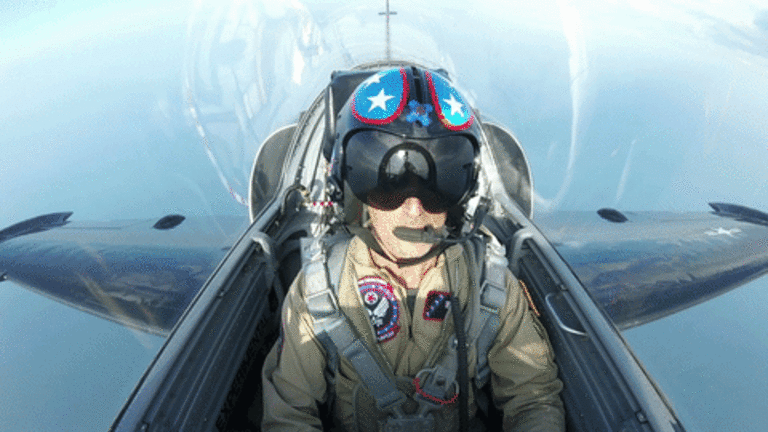 FacebookPinterest
FacebookPinterestWhich brought us to aerobatics, Crunchy’s specialty, and my new vote for most terrifying word in the English language. Aerobatics, in short, means making planes do things that are profoundly insane, on purpose and repeatedly.
In our first instance, that meant something called a "controlled stall," which is exactly 50% of a phrase you do not want to hear onboard a plane. A controlled stall is the following: Crunchy points the nose up and climbs, and climbs, and climbs, but he doesn’t give the jet any more power, so it’s slowly decelerating, until it reaches a speed slow enough to make the frame begin shuddering and the engines stall out. When that happens, the plane, with the eeriest calm, points itself nose down and begins falling toward Earth. Being in a plane plummeting toward the ocean, even knowing the iceman in the front seat has it under control, is unfathomably great and terrible, and in image that will never leave me. After my new record-time in freefall, Crunchy leveled us out, and brought us even, which was good, because that made it easier to throw up into a bag.
I threw up everything. Well, I would have, if I had eaten everything, which I didn’t, because I didn’t want to throw up a bunch of stuff, so I threw up nothing, which is, in many ways, worse than throwing up something. I threw up the morning’s coffee, some water, a Lunchable I had in 1998, most of my college graduation dinner, and all the gum I’d ever accidentally swallowed in my life, because everybody knows you can’t digest that stuff. Green and no longer human-colored, I politely asked Crunchy if we could maybe pass on the planned loop, the pull-back-on-the-throttle maneuver that would have brought us up and over and me probably throwing up things that other people had eaten. A gracious host, he agreed immediately, while very likely making notes about what to call me to Cowboy and Marsh later that night.
My nauseous request left us time to do what is now both of our favorite things: cloud-surfing. It’s exactly what it sounds like. Up, down, through, past, the only time you really get a sense of the speeds at which you’re traveling. The balanced position was welcome, but Crunchy fell right into his zone, zooming and twisting through gaps and valleys. “Closest you’ll ever get to the ‘Star Wars’ canyon,” he said. “I could do this all day.” We settled on doing it for 15 minutes.
After surfing, only one question remained: Upon landing, was I up for Option A — a lot of Gs — or Option B — not many Gs. I was a ready mess, cold-sweating and holding a bag of regurgitated gum from 1993, so no one was more surprised than me to hear me say, let’s try it.
Crunchy turned it hard. Up to 5 Gs, he told me, though those on the ground suspected less (when you throw up on your first flight, people get real generous with their estimates). Imagine Big John Studd taking a seat on your lap — it’s like that, only sideways. I’d been warned about GLOC, and I didn’t black out, but the grayening happened, a fuzzy fissure on the edges of my eyes. Too much more of that and I’d have napped my way to the ground. I popped out of the jet, fumbled my way down and promptly uncorked a three-minute stream of nonsensical adrenalin-fueled gibberish. Someone came up and spun me around — my back was a vertical puddle, soaked through in a near-perfect square, whereas Crunchy basically looked like he’d just arrived from a sandwich shop. "How can you sweat that much and still have water to barf out?” my brother asked later on. The human body is a truly miraculous thing.
Ninety minutes later, it was beers and burgers at the hotel bar, a steady stream of thanks and well-wishes stopping by Cowboy’s chair and deserved flight suit. People do this daily. All these men and women do this daily. Multiple times a day. Earlier in the day, I’d gotten a tour of VFA-32, a Navy strike fighter squadron, with men and women who land F/A-18 Super Hornets on aircraft carriers regularly, at the close of seven- or eight-hour missions that involve monitoring the input from 20 screens, processing it, making decisions and acting. Crunchy, Cowboy, Villain, Dagwood, retired from years of service, now flip planes for a living and support wounded warriors at the same time. If you hadn’t met any of them, if you viewed the group from 50 yards out, you’d identify immediately the camaraderie, respect and shared goal. It’s easy and established; innately I stood outside it, respectful but mostly intimidated of their circle. But for 29 minutes, I got to poke my head into a higher world, to see things from the broadest of perspectives. Today, their job is an air show, tomorrow it’s continued service. I’ll go back to the ground, and let them get back to being VIPs.

